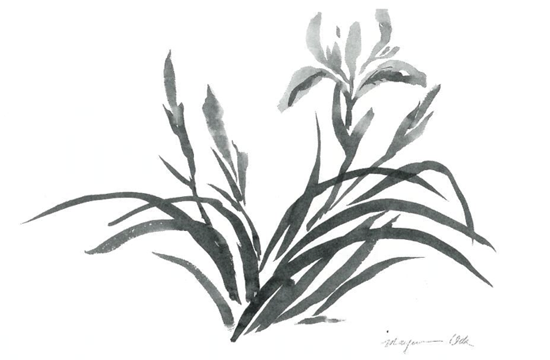
Spring is bellowing out now in California, full-throated spring, and I can barely catch my breath amid her explosive arias and high-pitched scales that run from January through the end of April. Time in the garden is told by linked events, and I mark the rapid ascent of spring by the unfurling of one of my favorite harbinger flowers, the wild iris of the Northwest Coast. With a mixture of panic and delight I notice the first iris blade, a slim white stiletto hidden within folds of wind-burned foliage. The winter pruning of elephant heart plums or the Gallica roses is still unfinished, and already spring irises are beginning to unsheathe!
Soon the frenzy of early coastal spring claims me completely. Forget about living in the present moment: Pruning presses on; the first flats of DiCicco broccoli and heirloom lettuce must be sown before the full moon; the compost needs to be aerated and turned; and sesshin is coming up. By the Ides of March the wild irises are in full cry, pulling me out of my skin.
This morning, however, I give up. At 6:20 a.m., en route to prune the last pear-apple tree in the garden, a drift of iris stops me in my tracks. There in the garden for one brief moment body and mind drop away. These showy flowers are tiny, as irises go, tenacious and dauntingly beautiful, growing from shallow rhizomes that radiate out in widening circles. The flowers are borne on foot-long stalks, rising like slender, curved serpents pushing through the sword-shaped foliage.
The iris has a history dating back thousands of years to ancient Egypt and classical Greece. The iridescent flash of lavender, pale rose, cream silk, glass-bottle blue, and dark purple that marks this genus is also responsible for its name and association with Hermes, the messenger of the gods, who travels the arc of the rainbow that connects heaven to earth.
From antiquity the iris has stood for power and majesty. Dedicated to Juno, laid as an offering on the brow of the Sphinx, and serving as the fleur-de-lis emblem of the French royal house, the three falls of the iris flower symbolize faith, valor, and wisdom. The innermost whorl of petals reveals intricate patterning that draws insects down into the heart of the flower, where pollen is trapped in exchange for sugary nectar.
In 1825 the great Scottish plantsman and botanist David Douglas pushed his way deep into the Pacific Northwest wilderness to “discover” this small iris, branding it and the towering old-growth fir trees above it with his name. Legend tells of Douglas fording the raging torrents of the Northwest wearing a tartan kilt and holding a wooden plant chest high above his head to protect his specimens from danger. Proud of his prowess, Douglas bragged, “You will begin to think that I manufacture new pines at my pleasure,” a conceit that was snuffed out suddenly when the explorer fell and was gored to death in a bullpen while collecting plants in Hawai’i.
I prefer the native Ohlone name for wild iris, ‘uuner, sounding more like “runner,” and that is how the iris grows. It runs in rainbow rings out from a tight center. The ‘uuner iris has long been prized for medicine and fiber. Each leaf has two semitranslucent strands, which native people have woven into pliant rope and cord for generations, fashioning intricate nets and snare traps from raw iris fiber.
The ‘uuner iris has snared me this morning. My abandoned pear-apple tree far in the distance. Caught in the net of timeless spring, I lean back into the iridescent field of flowers. Throughout the ten directions, rainbow iris messengers rustle in the spring wind.
Thank you for subscribing to Tricycle! As a nonprofit, we depend on readers like you to keep Buddhist teachings and practices widely available.